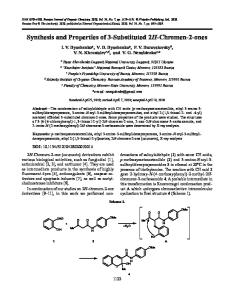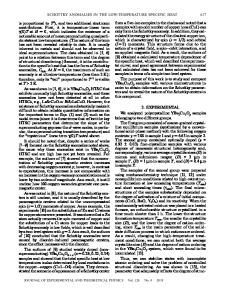Synthesis and Low Temperature Physical Properties of Metal Substituted CoSr 2 YCu 2 O y
- PDF / 220,010 Bytes
- 5 Pages / 612 x 792 pts (letter) Page_size
- 53 Downloads / 316 Views
FF6.8.1
Synthesis and Low Temperature Physical Properties of Metal Substituted CoSr2YCu2Oy. Masahiro Shiraki1, Jun-ichi Shimoyama1,2, Shigeru Horii1, and Kohji Kishio1 1 Department of Superconductivity, University of Tokyo, 7-3-1 Hongo, Bunkyo-ku, Tokyo 113-8656, Japan 2 PRESTO, Japan Science and Technology Corporation(JST), 4-1-8 Honcho, Kawaguchi, Saitama 332-0012, Japan ABSTRACT In the present study, hole carrier doping was attempted for CoSr2YCu2O7+δ which is a relating compound to a well known superconductor YBa2Cu3O7-δ by introduction of excess oxygen into CoO1+δ layer and cation substitutions. High valence metal substitution for cobalt and barium substitution for strontium were revealed to be able to introduce excess oxygen and generate hole carriers. Additional calcium substitution for yttrium enhanced hole carrier concentration p/Cu > 0.05 which was enough for superconductivity, however superconducting transition was not observed. This is possibly due to incorporation of cobalt in the CuO2 planes. INTRODUCTION CoSr2YCu2O7+δ (Co1212-Sr) is one of the layered cuprates having similar crystal structure to that of a well-known 90 K-class high-Tc superconductor YBa2Cu3O7-δ as shown in Fig. 1. In general, superconductivity of cuprates appears at moderate hole carrier concentration, 0.05< p/Cu< 0.27 (p/Cu: estimated hole carrier concentration per Cu site). In the Co1212, cobalt ions have tetrahedral coordination at the CoO1+δ layer and the oxygen content is quite stable at ~ 7.0[1], resulting in sufficient carrier concentration for superconductivity and was confirmed by the thermoelectric power measurement made at 290 K[2]. Partial high valence metal substitutions which usually form robust octahedrons in the layered perovskite-type oxides may disturb the oxygen ordering in the CoO1+δ layer accompanying a certain amount of excess oxygen. On the other hand, a related compound CoBa2YCu2O7+δ (Co1212-Ba) has excess oxygen. Therefore, partial substitution of barium for strontium can be also expected to change the oxygen ordering in the CoO1+δ layer. Recently, 40 K-class superconductivity was reported for the hole carrier doped Co1212-Sr[3] by partial substitution of calcium for yttrium and high pressure oxygen annealing under 5 GPa at 500°C for 30 min with Ag2O2. This result suggested that if enough amount of hole is introduced to Co1212 by other chemical method without ultra-high pressure technique, improved superconducting properties can be expected. Therefore, introduction of excess oxygen sites in the CoO1+δ layer accompanying hole carrier generation by high valence metal substitution was attempted in order to find new superconductors derived from Co1212 in
FF6.8.2
the present study.
Figure 1. Crystal structure of CoSr2YCu2O7+δ. EXPERIMENTAL Sintered bulk samples of (Co1-xMx)(Sr1-yBay)2(Y1-zCaz)Cu2O7+δ (M = Ti, V, Mo, Re) were synthesized by the conventional solid state reaction starting from high purity powders of Co3O4, TiO2, V2O5, MoO3, ReO3, SrCO3, BaCO3, Y2O3, CaCO3, CuO. Powder mixtures were calcined at 90
Data Loading...











